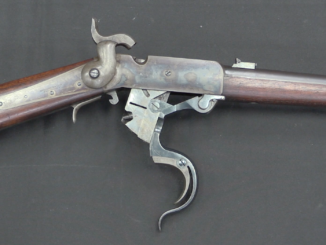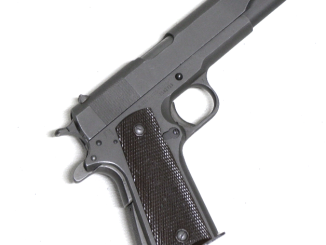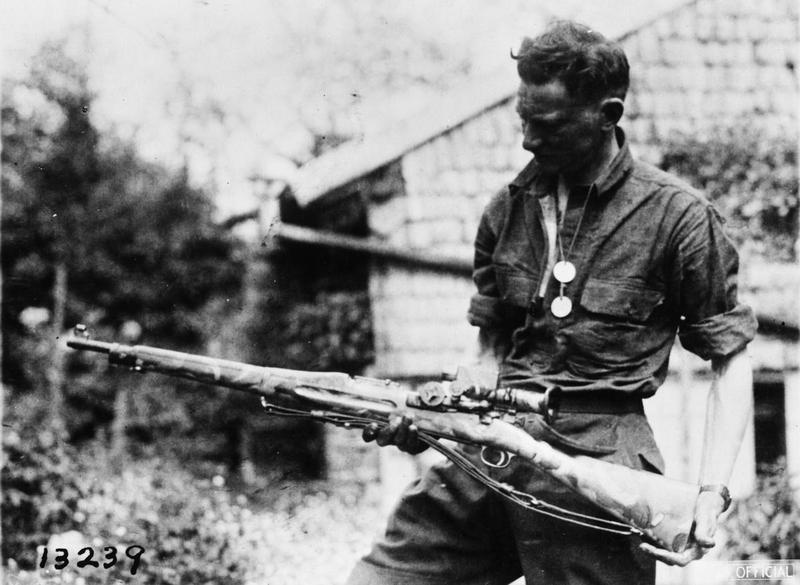Have you heard of Jonathan Browning, gunsmith and inventor? Among his other accomplishments, he is credited with designing the harmonica rifle in the US – and we have an example of one of his hand-made guns here to look at today (made in 1853). Browning was a Mormon, and spent several years slowly moving west periodically setting up gunsmithing shops before he reached his final destination of Ogden, Utah. There he settled down for good, and had 22 children with his 3 wives. One of those children also showed an aptitude for gunsmithing, and formally apprenticed to his father. You might recognize his name…
Related Articles

Single Shot Rifles
America’s First Metallic Cartridge: The Burnside Carbine
The Burnside carbine was originally invented by Ambrose Burnside – the man who would later command the Army of the Potomac and after whom sideburns would be named. Burnside came up with the idea while […]

Semiauto pistol
M1911A1: America’s Definitive World War Two Pistol
The United States adopted the M1911 pistol just in time for the First World War, and between Colt and Springfield Arsenal some 643,000 of these pistols were made by the end of 1918. During that […]

Bolt Action Rifles
Vintage Saturday: Sniper
Springfield 1903 sniper w/ Warner & Swasey M1913 scope, photo taken in 1918. Note the camouflage pain on the stock, and the distinctive cruciform grasping knob on the range adjustment of the scope.

All it would need for easier indexing wwould be a flat spring on top or bottom and some groves in the magazine block. Would have been simple and cheap to add, then you just push the magazine sideways to the next detent.
anyway nice gun and the workmanship seems to be really good.
I thought a little stud on the bar locking roller in a zig-zag slot on the harmonica would let you move it to the next chamber; like the Webley-Fosbery automatic revolver.
Also in a powerful shoulder rifle in the 1830’s-50’s what would have been your faster loading repeaters besides 6 shot revolver rifles? The single shot paper cartridge Sharps spring to mind, on reloading speed.
While you’re at it, add some sort of retention devices on either end of the chamber block so that it doesn’t fall out on the ground if it comes unlatched. I don’t imagine that Ian was the first person to drop it.
Join the both ends of harmonica shaped magazine and it suddenly becomes a revolver. This should be the reason why this kind of repeaters being not popular.
Interesting video. I’ve noticed American firearms developers are heavily mythologized–almost sainted, and it’s pretty rare to get a glimpse into their lives and backgrounds.
How is it that a member of the Church of Latter Day Saints never had a moment of trouble doing business with Belgians? Why is it that the U.S. Army teaches shooting from the prone position, yet resisted firearms that fed from the side or the top?
Try running around with a Sten or a Bren through underbrush. The Johnson Light Machine Gun also suffered from being snag prone. John Moses Browning likely did NOT mention religion with business abroad…
As for this harmonica gun, I still think I’d rather take a Sharps, a Dreyse, or even the crappy Podewils Linder conversion (no ram rod required for loading any of those rifles, and no fiddly parts to lose while loading unless you’re a klutz).
John Browning went to Belgium after he had some problems with Winchester. I’m not sure what problems he would have had in Belgium? I’m hardly an expert on Mormons, but they had disavowed polygamy well before that point and were trying, more or less, to reintegrate themselves into mainstream America after having made their retreat to Utah in the previous century. He would have been prohibited from drinking alcohol (if business was commonly done over dinner with wine, etc.), but that was en vogue anyway in that era with some people.
Add to Cherndog’s reply on top and side mags, that some people liked the M1 Garand because it did not have ANY magazine sticking out. Although, ironically, Garand’s design for a carbine had a top mounted magazine (Ian has a page on that rifle).
Regarding the rifle in the video, it would have been most useful for a lone pioneer of that era who had to defend against Indian attacks. Some of the Indian tribes had a tactic where would group would feint a charge to get the defenders to discharge their rifles, then the main force would charge and over run the defender(s) who were fiddling with ram rods at that point. For a lone frontiersman in a cabin or a dug out with a family to defend, it would be no gimmick but a rifle with real possibilities.
I saw a replica of this rifle done for a New Zealand Movie some years back. I guess they thought it visually interesting?
If you’ve ever seen “Adios, Sabata” aka “Indio Black” aka “The Bounty Hunters” with Yul Brynner (1970), Brynner uses a “mare’s leg” style weapon that works on this principle. I’m not aware of any “Continental” rifle it could have been modified from, so it may have been made specifically for the movie.
It had a lever and hammer like a standard lever-action, and I believe the idea was that as the lever was racked it would both cock the hammer and index the loading block over one “chamber” to bring a fresh round under the hammer. In the movie, it apparently didn’t work, because Brynner, firing from the hip, had to move the block across with the fingers and thumb of his off hand to keep it working.
I’ve often wondered if this sort of mechanism could be combined with John Moses Browning’s early “gas-flap” self-actuating mechanism for a tubular-magazine lever action to create a very rapid-fire “Wild Wild West”-style automatic rifle. By simply shoving a loaded, say 20-round, “block” in, you eliminate the reloading lag of the tube magazine arm in automatic fire.
Make it a .44-40 WCF, and it would almost qualify as a proto-“assault rifle”, even more than the Henry, etc., did in their own era.
cheers
eon
Sam Houston’s rifle may have pre-dated Browning’s rifle.
A biography of J.M. Browning written(with Curt Gentry) by his son, also named John Browning, mentions these weapons; there are photos of them in the book. Earlier versions had the caps and hammer on the bottom, hammer powered by a leaf spring that doubled as trigger guard. Authors attribute this parsimony by dad as inspiration to son’s habitual later use of individual parts having multiple purposes; e.g. takedown pin/slide lock, safety catch/rear sight, and of course the idea of the slide itself, which combines breechblock, recoil spring holder, locking mechanism, dust cover for the entire action, barrel protector, sight housing, etc. etc.
Ian,
The Mormons arrived in Quincy, Illinois in the winter of 1839 and were given shelter by the good citizens of the city. A few years ago the Mormon Tabernacle Choir performed in Quincy as a thank you for what there ancestors had done. The Mormons then moved up the river to a small settlement called Commerce and renamed it Nauvoo. It is pronounced Naa Vu. It became the largest city in Illinois with just over 11,000 by 1845. They were driven out starting in February of 1846 and by the fall of 1946 had abandoned the city.
Jonathon moved his family to Nauvoo after joining the Mormon Church and built a large two story brick house on the main street and then extended the walls of the house to create his gun smith shop. Starting in 1965 the Mormon Church restored the Jonathon Browning home and gunsmith shop along with the entire city. Anyone visiting can see the house and shop today. (He even buried a infant child on the property and the grave was located and marked during the restoration.) Brigham Young then had him move west, I believe to what is now Sioux City, Iowa, but what was then called Mosquito Creek, and set up shop to provide guns and other tools to Mormon companies heading for Utah. I believe he stayed in Iowa until the early 1850’s when he moved to Utah, settling in Ogden where he set up a gunsmithing business that employed several of his sons including John Moses Browning.